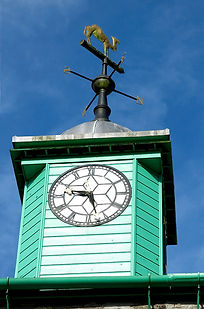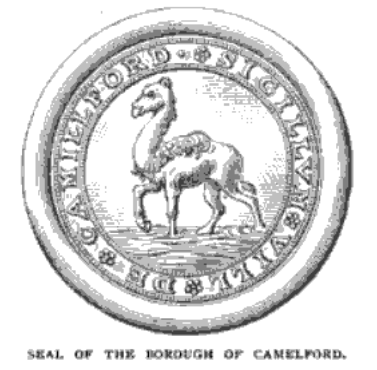Parliament and Politics
On July 24, 1669, Charles II granted a new charter to the borough of Camelford. On that occasion Ambrose Manaton (1648-1696) presented the corporation with a ceremonial mace that is still in use at Camelford today. The mace is silver gilt and 19 inches in length. I have posted an engraving of the mace and a picture of its recent ceremonial use. On the base is engraved: "Ex dono Ambrose Manaton, Armig. anno dom. 1669." The seal is circular and bears the image of a camel fording a river, an allusion to the town, which is situated on the river Camel. Whether or not this idea originated with Ambrose I cannot say. However, the camel is proudly displayed on at least one weather vane in town today. In later years, Ambrose was returned as MP for Camelford from 1689-1696 and the Manaton family maintained holdings in Camelford as late as 1771.



Ambrose and Henry were returned to Parliament from 1678 until 1715. By the time that Ambrose first stood for elections to Parliament there were not yet parties in Parliament organized along contemporary lines. But, the impetus was taking shape. There emerged from the Exclusion Crisis of 1679 two political factions contesting for power over the government, the Whigs and the Tories. The Manaton sympathies were Tory.
Ambrose began his representation at Newport between 1678 and 1681, followed by Camelford, where he was joined by Henry in 1689 and 1690, then Ambrose again in 1685 and 1696. The attention of both brothers was then turned to Tavistock, where Ambrose was returned in 1696, before his death. Henry then divided his attentions between Camelford and Tavistock until his death in 1715, also returned once for Callington in 1712.
Newport appears to have been a Tory borough, but control may have been divided between the Edgcumbe family and its extended network of kinship. Edgcumbe’s influence was also felt in Camelford, an open borough, where sympathies were also Tory. This may have had a part in the Manaton elections. Callington, nearby to the manor and barton of Manaton may also have been Tory. But, in Tavistock, the Russells represented strong Whig opposition.
The manor and borough of Tavistock was granted to the Russell family in 1539 who used their position to actively influence the returns to the Commons. During the Civil War Tavistock went over to the Parliamentarians under the influence of William Russell, 1st Duke of Bedford KG PC, although he switched allegiances during the course of the war. At the Restoration of 1660, Bedford bore the sceptre at Charles II's coronation in 1661, but he was never close to the king despite the king’s efforts to court him at one point between 1671-1673. Bedford’s son William Russell, Lord Russell (1639 – 1683) was a leading member of the Country Party who laid the groundwork for opposition in the House of Commons to the accession of an openly Catholic king in Charles's brother James. Bedford supported Shaftesbury and the Whigs during the Exclusion Crisis. The king consequently turned against Bedford, and, in 1682, the family borough of Tavistock lost its charter. Russell opposition to Charles II may ultimately have led to the execution of William Russell, Lord Russell for treason for his part in the Rye House Plot in 1683. Following his son's execution in 1683, Bedford withdrew from politics, but Bedford returned to public life at the time of the Glorious Revolution. He again carried the sceptre at the coronation of William and Mary, and was made a member of the Privy Council.
In Tavistock, the Russells enjoyed the support of fellow Whigs such as Sir Francis Drake, 3rd Bt., who owned nearby Buckland Abbey and property in the borough itself. On the Tory side the leading interest was that of the Manatons of Kilworthy (just over a mile from Tavistock), who were trustees of the parish lands. In 1690 Hon. Robert Russell, brother of the Earl of Bedford (William Russell), shared the representation with Drake, defeating Ambrose Manaton, who petitioned on 24 Mar. 1690, alleging partiality by the portreeve. The case was finally reported on 8 Dec. 1691, when the House resolved in favour of Drake, despite accusations that his majority included 19 unqualified voters. Drake stood down in 1695, informing Sir George Treby on 31 Aug. that ‘the High Tories and Jacobites of this town are mostly at Manaton’s devotion. But I am told his party is not so considerable as it was.’ Drake nevertheless believed it would be difficult to defeat Manaton ‘unless some pretty considerable person is brought forward’, adding that ‘my lord of Bedford’s interest will be needful’. At the election Lords Robert and James Russell were returned.
On 29 Nov. Manaton petitioned against Lord James, who declined to offer any defence (presumably because he had also been returned for Whitchurch) and was therefore unseated on 12 Mar. 1696. Manaton died shortly afterwards and Drake was returned at the ensuing by-election, defeating Manaton’s brother, Henry, who petitioned on 25 Nov. The poll by which Manaton claimed to have won the election included numerous freeholders who had not been formally presented at the court leet. His counsel attempted to validate this franchise by citing the previous decision of the House in favour of Ambrose Manaton. It was argued for Drake, however, that the former ruling was not binding (not least because in 1695 the unseated candidate had offered no defence), and the House voted by 196 to 86 in favour of the narrower franchise and Drake’s election. Lord Robert Russell and Drake were unopposed in 1698.
Created Duke of Bedford in 1689 and Marquess of Tavistock in 1694 on his death in 1700 the Bedford dukedom passed to a grandson, young Wriothesley Russell, 2nd Duke of Bedford KG (1680 – 1711). He was a Gentleman of the Bedchamber to William III from 1701 to 1702. After William's death, he was invested as a Knight of the Garter on 14 March 1702 and served as Lord High Constable of England for the coronation of Queen Anne.
At the two 1701 elections, Lords Edward and Robert Russell were returned, defeating on each occasion James Bulteel, a young Tavistock attorney, whose father and grandfather had been prominent citizens. No decision was taken on either of Bulteel’s petitions (18 Feb. 1701 and 3 Jan. 1702), despite the fact that in both Parliaments Lord Edward had also been returned for Bedfordshire and never chose between his two seats. Lord Robert was re-elected in 1702, this time in partnership with Lord James Russell. Henry Manaton petitioned against the latter on 24 Oct. 1702. Two resolutions were reported from committee on 19 Jan. 1703. The first confirmed that presentment was a necessary qualification to vote, but this was rejected by 118 votes to 101. The second resolution, in favour of the sitting Member’s election, was thereupon recommitted. No further report emerged in this session. Following the renewal of Manaton’s petition on 10 Nov. 1703 and the submission in evidence of another poll, it was resolved on 21 Dec. that, with Lord James offering no defence, Manaton should be seated.
At the 1705 election there was no Russell candidate, perhaps owing to a rift with Drake. Manaton and Bulteel were returned without opposition. In 1708 Sir John Cope, a young Whig outsider, was returned on the Bedford interest, and apparently in connivance with Manaton, as Drake wrote to (Sir) Peter King, ‘I think tis agreed by all sides that Bulteel is dropt at Tavistock and that the Duke’s interest is revived again and Manaton safe’. In May 1710 the Tory interest received a boost from a visitation by Francis Atterbury, in his capacity as archdeacon of Totnes, accompanied by Dr Sacheverell. Prior to this event it was already being reported that the Bedford interest would ‘not go forward’ at the 1710 election. However, Cope stood again (as the only Whig), and most of Manaton’s voters also voted for Cope, suggesting that the alliance with the Russells was still in being. Cope also drew support from Bulteel, who was in effect challenging Manaton for the second seat. A third Tory, Christopher Harris*, also stood, all his voters backing Bulteel. According to one Tory newspaper, Bulteel received considerably more votes than Manaton, but ‘the portreeve at the instigation of persons of his own sect (who have a great aversion to Mr Bulteel, a gentleman of eminent zeal for the established Church of England) declared and returned Sir John Cope and Mr Manaton’. Bulteel petitioned on 1 Dec. 1710 against Manaton. In the report on 3 Feb. 1711 the right of election was agreed simply to be in the resident freeholders, with no mention of their having to be presented at the lord’s court. Witnesses for Bulteel testified that the portreeve had added two unqualified votes for Manaton and disallowed 17 good votes for Bulteel; that he had personally canvassed for Manaton, offering money (£3 to £5 a vote), places, leases or extension of leases, and declaring that he would not return Bulteel even if he had 40 votes more and that ‘Mr Manaton would indemnify him, if it cost £1,000 for returning him’. After the election the portreeve was said to have tampered with Bulteel’s witnesses, offering one of them 20 guineas not to go to London to testify before the elections committee. Without a division Bulteel was seated in Manaton’s place and the portreeve declared guilty of a breach of privilege and sent for into custody. Sir Arthur Kaye, 3rd Bt.*, wrote in his diary that bribery and corruption had appeared just as ‘flagrant’ on the part of Cope as Manaton. There was no contest in 1713, Cope and Bulteel sharing the representation. Henry Manaton, who stood for election in 1715, died that same year.
Manaton Representation in the House of Commons
Family Member Constituency Dates
Ambrose Manaton (1648-1696) NEWPORT Feb. 1678 - Mar. 1681
Ambrose Manaton (1648-1696) CAMELFORD 1689 - 12 Mar. 1696
Henry Manaton (1650-1716) CAMELFORD 1689, 1690
Ambrose Manaton (1648-1696) TAVISTOCK 12 Mar. - ? Oct. 1696
Henry Manaton (1650-1716) CAMELFORD 1698, Feb 1701, Dec 1701, 1702- 21 Dec 1703
TAVISTOCK 21 Dec 1703, 1705, 1708, 1710-3 Feb
1711
CAMELFORD 26 Mar - 8 May 1711
CALLINGTON 11 Feb. 1712
